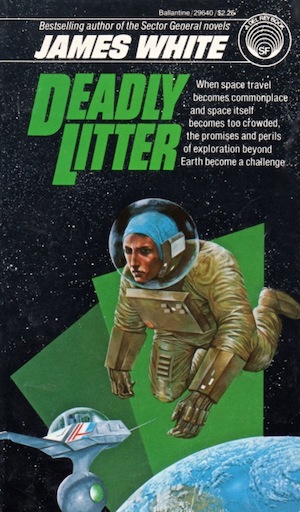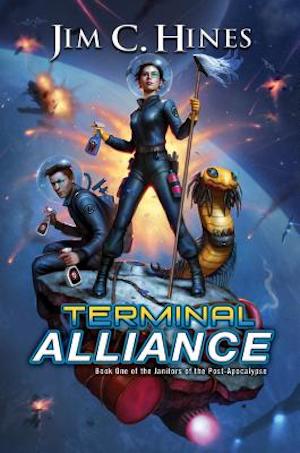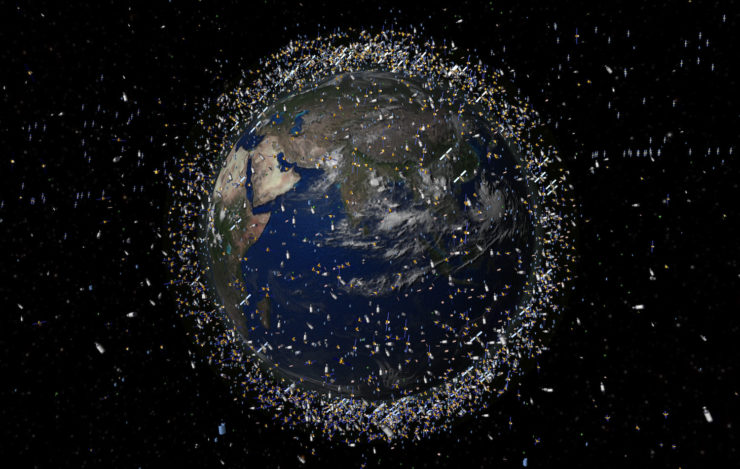If there is one lesson that the popular film Space Sweepers teaches us, it is that audiences worldwide love science fiction about garbage and garbage collection. SF fans eager for more thrilling tales of garbage collection will be overjoyed to learn that science fiction is rich with examples of prior art. Consider these five works…
Deadly Litter by James White (1959)

One hundred and fifty years of energetic space development prove that not only is there no frontier that humanity cannot eventually reach, but also that there are no pristine wildernesses that humans cannot sully with discarded trash. Space trash, moving as it does at the speed of meteorites, is far more deadly than the terrestrial variety. Discarding waste in space is illegal.
While it is impossible to eliminate all space-littering, simple Newtonian physics can implicate the culprits. Thus, the crew of Police Survey Ship Descartes traces the sudden violent deaths of eighteen men on their wrecked spacecraft to the actions of the crew of the Sunflower eleven years earlier. If further deaths are to be avoided, Descartes needs to determine the precise orbit of the so-called “Sunflower Drift.” Former Sunflower engineer James Andrew Caulfield could provide the clues needed… if he could even remember the catastrophic events of eleven years past.
***
Quark (TV series), created by Buck Henry (1977–1978)
Adam Quark (Richard Benjamin) commands a United Galaxy Sanitation Patrol Cruiser operating out of United Galaxies Space Station Perma One. It’s an unpleasant but necessary task, complicated by the fact that Quark has a boss who is both craven (when dealing with superiors) and bullying (when dealing with underlings like Quark). As often as not, Quark and his crew find themselves dealing with crises well beyond their paygrade, crises that are suspiciously similar to the plots of famous SF television episodes and movies.
Assisting Quark is a diverse array of clones, robots, and aliens, each of whom did their best to show just how badly comedy can age in just forty-odd years.
***
Planetes by Makoto Yakimura (1999–2004)

Thanks to inexpensive lunar Helium-3, space from low Earth orbit to the Moon has been heavily industrialized. As human populations soar, so too does the amount of debris in space—bad news for anyone who gets in the way of a Mach 30 bolt. Just ask Yuri Mihairokov’s wife—except you can’t, because her space shuttle was struck by debris and her body was never recovered.
The crew of the DS-12—Hachirota “Hachimaki” Hoshino, Yuri Mihairokov, Ai Tanabe, and Fee Carmichael—are among the stalwarts of Technora Corporation’s Space Debris Section. They work tirelessly to control the space debris problem. Necessary is not the same as “valued,” however. The DS-12 crew may be lifesavers but to other space workers, they’re just the garbage collectors.
***
Terminal Alliance by Jim C. Hines (2017)

The Krakau found an Earth that has been overrun by the bestial survivors of a planetary plague. Still, better half a glass than an empty glass. The benevolent aliens retrieved suitable candidates from the raving hordes and applied suitable cognitive corrective measures. Lo and behold, humans were transformed from wandering monsters to trustworthy subordinates. Although perhaps not all that trustworthy. Humans are relegated to menial tasks.
Marion “Mops” Adamopoulos is in charge of Earth Mercenary Corps Ship Pufferfish’s Shipboard Hygiene and Sanitation team. Chief janitor, in other words. Not command crew. Except that an unexpected attack eliminates her Krakau commanders while most of Pufferfish’s humans revert into beasts. Mops has no choice but to take command of a ship neither she nor the remaining non-bestial humans know how to operate.
***
Orbital Cloud by Taiyo Fujii (2014)

Shooting-star-prediction site Meteor News is the first to notice the SAFIR 3’s booster rocket’s bizarre behaviour. Rather than re-entering and burning up, the Iranian rocket’s second stage is somehow, inexplicably, ascending towards higher orbit despite seemingly lacking the means to do so. How this is possible is unclear, as is the purpose in sending a seemingly expended rocket stage into low Earth orbit.
Ill-informed nincompoops panic over the possibility someone has orbited the first ever Rod from God, a potential hyperkinetic weapon. While the mysterious object is a kinetic weapon—forty thousand kinetic weapons, to be exact—the intended target is not on Earth itself. The rocket’s payload is targeting anything currently in Earth’s orbit. If an ad hoc international team cannot work out how to safely remove the weapon from orbit, forty thousand kinetic weapons will annihilate Earth’s satellites and space stations, filling the region near Earth with debris and ending space flight for the foreseeable future.
***
No doubt for each example I thought of, many of you can think of ten examples that you are astounded I did not mention. The comments are below!
In the words of Wikipedia editor TexasAndroid, prolific book reviewer and perennial Darwin Award nominee James Davis Nicoll is of “questionable notability.” His work has appeared in Publishers Weekly and Romantic Times as well as on his own websites, James Nicoll Reviews and Young People Read Old SFF(where he is assisted by editor Karen Lofstrom and web person Adrienne L. Travis). He is a four-time finalist for the Best Fan Writer Hugo Award and is surprisingly flammable.










